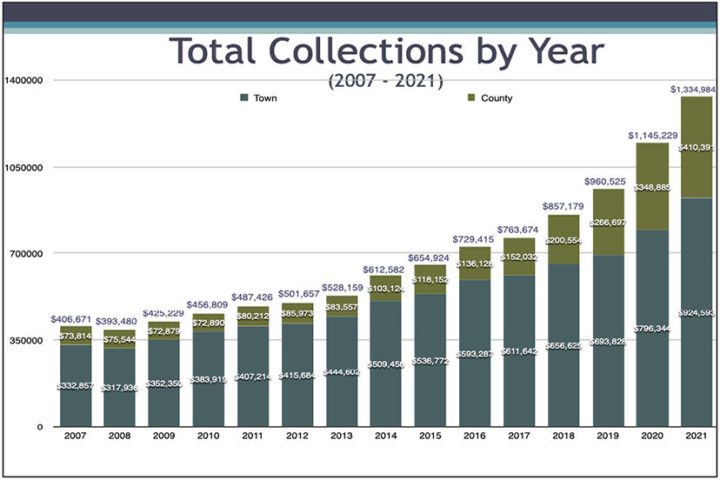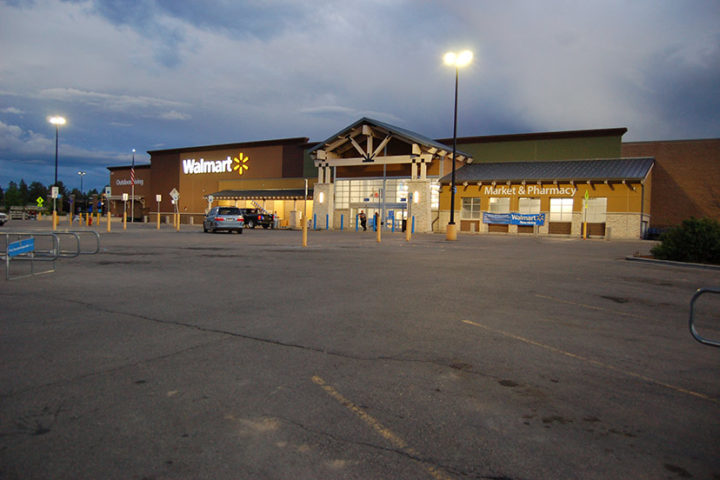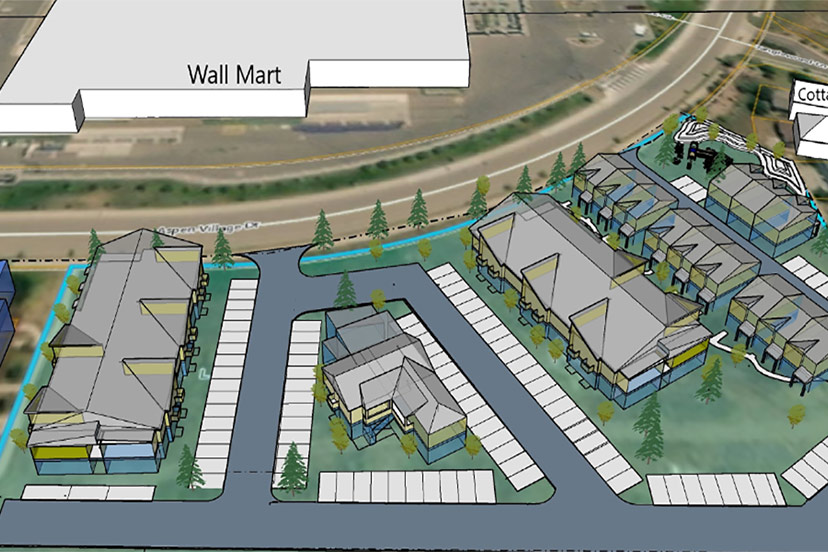IMAGE: Sketch of possible Town-sponsored housing projects just south of Walmart.
Over the past 16 years, our two key governments — Archuleta County and the Town of Pagosa Springs — have spent about $11.7 million in tax revenues to promoting the local tourism industry, including the estimated spending for 2022.
As far as I know, no other local industry has seen this kind of entitlement spending.

We can qualify those comments by noting that the tax revenues spent by the Town Tourism Committee, and then later by the Pagosa Springs Area Tourism Board, came from Lodgers Tax paid by the tourists themselves.
The assumption behind this spending? That more and more tourism would make Pagosa Springs residents more and more economically secure.
In fact, the exact opposite has taken place. Pagosa Springs households — especially working households — are now facing the highest cost of living in southwestern Colorado, while wages have lagged behind other communities. From a recent Region 9 Economic Development District report:
We found that in Region 9, Montezuma County is the least expensive ($71,292 annually), and Archuleta County is the most expensive place to live ($92,796 annually) for a family of four…
At this week’s Town Council meeting, the Council members heard a presentation about a potential $20 million ‘workforce housing’ project that could provide perhaps 58 apartment units, with average rents priced at about $1,889 a month. In no sense of the word would these units be ‘affordable’ to a typical working household in Pagosa Springs — and this, in spite of the fact that the suggested rents would supposedly benefit from a possible $9.5 million grant subsidy from the state of Colorado.
Of course, the Pagosa Springs Area Tourism Board is not solely responsible for this unfortunate turn of events. Most of the blame must go to national trends, and federal and state policies beyond our local control. Additional blame can be assigned to the Short-Term Rental industry, although it’s not clear just how much of the problem is being caused by STRs.
At the Tuesday Council meeting, the Town’s Community Development Director James Dickhoff explained that he had collaborated with the housing experts at Servitas in putting together a grant proposal to Colorado Department of Local Affairs, affectionately known as ‘DOLA’. The maximum allowable request for this particular grant was $10 million; perhaps the Town was being a bit coy in requesting ‘only’ $9.5 million? That would leave the Town with an $11 million loan to pay back, over 35 years. Supposedly, the rents collected from the 58 units would providing the funding to repay the loan.
Assuming, of course, that renters could be found. Ideally, working families and individuals.
The Aspen Village subdivision, where this project is being proposed, is located near the west end of town, and was originally designed in 2006 as a ‘live, work, play’ mixed-use subdivision, to include a mix of commercial and residential development. Maybe a couple of churches? Office buildings? Retail stores? Lots of homes and apartments?
16 years later, the subdivision has attracted only a modest amount commercial or residential development —if you don’t count the community’s largest retailer, Walmart.

Listening to the Council discuss the proposed Servitas project behind Walmart, it certainly doesn’t sound like a ‘done deal’. In fact, it sounds like the project will not move forward unless DOLA comes through with a $9.5 million grant.
Some folks will argue that governments should not be using tax money to promote safe, affordable housing. But after 20 years of using tax money to promote a tourism industry, the community leaders in Pagosa Springs might be realizing they should have been spending at least some of that money on places for tourism industry workers to live.
Following the Tuesday Council meeting, the Town staff kindly provided me with the spreadsheets that Servitas Vice President Garrett Scharton had displayed on the video screens in the Council Chambers. The numbers were much easier to read when printed on paper.
Not being an expert in housing industry financing, I was just barely able to follow that presentation from the audience. A couple of things stood out to me. One, the Town taxpayers would be accepting 100% of the risk on this housing project, if the market turned south. The developer — Servitas — appeared to be taking no risk whatsoever. They would be covered, no matter what happened to the real estate market in Pagosa Springs.
Another thing that stood out. Slightly lower estimated rents.
Back in November, when Servitas Vice President Garrett Scharton presented a previous ‘pro forma’ at a Council meeting, the proposal showed apartments at four ‘income levels’:
80% of AMI (Area Median Income)
100% of AMI
120% of AM
150% of AMI
The monthly rent for a studio apartment (no bedroom) ranged from $1,151 to $2,160. The monthly rent for a two-bedroom ranged from $1,480 to $2,775.
In the January 3 version of the project — based upon a hoped-for $9.5 million grant, and again broken down into four income levels — the monthly rent for a studio ranged from $1,061 to $1,925. Monthly rent for a two-bedroom ranged from $1,374 to $2,484.
In other words, although 40% of the project costs would (hopefully) be funded by a state grant, the rents had been reduced relatively little.
I personally would have liked to see the proposed rents dropped by 40%, if indeed that much of the project were state-subsidized. But that’s not what Servitas is proposing.
At the other end of town — the east end, out past the Highway 160/84 intersection — we come upon the entrance to the Running Iron Ranch, a 660-acre ranch and gravel-mining operation purchased in 2008 by our two water districts — Pagosa Area Water and Sanitation District (PAWSD) and San Juan Water Conservancy District (SJWCD) — as the future site for the Dry Gulch Reservoir. Basically, 660 acres of a gently sloping valley, where the water districts once had ambitious plans to build a 32,000-acre-foot reservoir. About 16 times the size of Lake Hatcher, if you want a comparison. The Weber family, who sold the ranch to the taxpayers for $10 million, were allowed to continue ranching and mining on the property, as part of the purchase agreement.
But the reservoir plans were put on the back burner in around 2011, for a number of reasons.
Could this ranch… possibly… be a site for truly affordable housing?

